This butterscotch cake is a rich cake with a deep butterscotch flavor made with dark brown sugar, then covered in a creamy butterscotch frosting.
If you look back on your childhood and remember that old-fashioned cooked butterscotch pudding fondly, then I hope this cake brings you back.
This cake is packed full of butterscotch flavor. From the pudding that’s added, to the deliciously decadent dark brown sugar. It’s a cake that’s not your usual cake and one the family will love.
The butterscotch frosting is so creamy and delicious and has a wonderful caramel flavor thanks to the added melted butterscotch chips.
The nice thing about this cake is that it’s a scratch cake, but it’s still quite easy to put make and put together. It makes a perfect birthday cake or just make it anytime you get a craving for that butterscotch flavor.
Hey there! Before you scroll, there’s lot’s of important stuff in the post!…including the FAQ section, which may answer any questions you might have about this recipe. Enjoy!
Jump to:
Ingredient Notes:
Now let’s talk about just some of the ingredients that are in this butterscotch cake recipe. (The list of all ingredients are in the recipe card below.)
All-Purpose Flour: No fancy flour is needed for this cake. All-purpose flour provides structure and texture to this cake while also serving as a binding agent for the other ingredients.
Butterscotch Instant Pudding Mix: The butterscotch pudding mix adds a rich butterscotch flavor and it adds moisture to the cake. A small amount is also reserved for the frosting to enhance its flavor.
Unsalted Butter: Butter adds moisture, richness, and flavor to both the cake and the frosting. It contributes to the tender texture of the cake and the creamy consistency of the frosting.
Dark Brown Sugar: Brown sugar not only sweetens the cake but it also adds a deep rich flavor. It also enhances the moistness of the cake and adds a beautiful dark color to the cake.
Eggs: Eggs provide structure, moisture, and help bind the ingredients together. They’re also used for the overall texture and stability of the cake.
Milk: Milk adds moisture and richness and helps to create a tender crumb.
Vegetable Oil: Vegetable oil also adds moisture to the cake and helps to actually keep it moist over time. It works as a complement to the butter and contributes to the cake’s texture.
Vanilla Extract: Vanilla extract is a flavor enhancer and it provides a subtle, sweet taste. It also helps to balance and enhance the other flavors in this recipe.
Baking Powder and Baking Soda: Baking powder and baking soda are leavening agents that help the cake rise and become light and airy.
Butterscotch Chips: Melted butterscotch chips add flavor and sweetness to the frosting and give it that butterscotch taste.
Confectioner’s Sugar: Confectioner’s sugar (powdered sugar) sweetens the frosting and helps create its smooth texture.
How to make this cake and frosting:
Let’s talk a little about how to make a butterscotch cake and frosting from scratch (The exact instructions are in the recipe card below.)
Step 1:
First, make the cake. Start out by preheating the oven to 325 degrees Fahrenheit and grease or spray a 13×9 inch pan and set aside.
Step 2:
In a medium-sized mixing bowl, add the flour, baking powder, baking soda, salt and package of butterscotch pudding mix (making sure to reserve one tablespoon of the mixture for the frosting). Whisk well and set aside.
Step 3:
In another bowl, add the eggs, milk, oil and vanilla. Whisk well.
Step 4:
Now in a large mixing bowl, cream the room-temperature butter and the brown sugar on medium-high for about two minutes.
Alternately add the flour mixture and the milk mixture to the butter and sugar being careful not to mix very long.
Step 5:
Now bake at 325 degrees F for about 45-50 minutes.
Step 6:
While the cake is cooling, you can make the frosting. Melt the butterscotch chips for about 20 seconds at a time. Mix until smooth and set aside to cool a bit before making the frosting.
Step 7:
Add the butter, and cooled-down, melted butterscotch chips to a mixing bowl and beat until smooth, then add three cups of confectioners sugar and beat on medium until smooth.
Step 8:
Next, add in 2 tablespoons of milk plus vanilla extract and the last two cups of confectioners sugar plus the salt and beat again until smooth. Add in the tablespoon of butterscotch pudding mix and mix well.
Step 9:
Spread frosting onto the completely cooled cake.
Tips & FAQs:
This cake is made using dark brown sugar which gives it a nice deep butterscotch and caramelly flavor. You’ll also add in a bit of butterscotch pudding mix to give it a boost of flavor and then it’s topped off with buttercream frosting made with a touch of butterscotch pudding mix and melted butterscotch chips.
Use the instant butterscotch pudding. Don’t use the sugar-free, or the cook-and-serve pudding mix.
You don’t want to actually mix up the pudding mix per the box instructions. You will just use it dry to the cake batter and the frosting.
Unsalted butter is best as you can better predict how much salt is added to the cake batter and frosting. If you can’t get unsalted butter, then feel free to use salted butter, but omit any salt that the recipe calls for both in both the cake and the frosting.
You really don’t want to substitute the butter for something else. This cake really depends on the rich flavor of the butter. It combines with the dark brown sugar and that’s what helps give it that butterscotch taste.
For both the cake and the frosting, make sure that the butter is almost room temperature. Don’t microwave it or melt it, just let it sit out of the fridge to come to room temperature.
Use dark brown sugar if you can get it. It will give it that deep caramel flavor.
You can and the cake will still taste good, but the flavor will not be as deep and butterscotchy as if you’d used the dark brown sugar.
You can find these on the baking aisle at various grocery stores. They’re usually where the chocolate chips are located.
Melt the butterscotch chips ahead of time and let them cool a bit before making the frosting.
No, you can omit that ingredient, however the frosting will not have as much butterscotch taste.
Reserving a tablespoon of butterscotch pudding mix for the frosting intensifies the butterscotch flavor.
This cake is done baking when a toothpick inserted into the center comes out with a few moist crumbs on it or clean, but no raw batter.
This cake can be stored for a day at room temperature, covered well. After that, store in the refrigerator, well covered.
This cake will last about 6 days if kept covered and in the refrigerator.
I have not tested this recipe out as cupcakes, but it may work just fine. You’ll want to fill cupcake liners about ⅔ of the way full and bake at 350 degrees. Start checking for doneness around 20 minutes.
I have not tested this recipe out as a layer cake, but it should work just fine if using two 8″ round cake pans. Bake at 325 degrees and start checking for doneness at about 40 minutes although it may need to bake for a little longer. A toothpick inserted into the middle should come out with a few moist crumbs, but no raw batter.
Probably although I haven’t tried it out. If you do try it, make sure to grease and flour the bundt pan very well so that it doesn’t stick. Bake at 325 degrees F for the same amount of time although it will likely take longer to bake since a bundt pan is deeper. Do not pull it out until the cake is fully baked. The cake will be firmer to the touch and not jiggly and a toothpick inserted into the cake will come out either with a few moist crumbs on it or clean.
This cake should be just fine if frozen correctly. Wrap either the 13×9 inch cake or the round cake layers in plastic wrap, then in foil to prevent freezer burn. This cake can be frozen for up to a month.
To defrost, set the wrapped cake onto the counter and let defrost while still wrapped (about a couple of hours). Once defrosted, take the wrappings off and add frosting.
This cake is best served close to room temperature. If the cake is cold, set it out to come closer to room temperature for about 20-30 minutes before serving. You can also microwave slices for about 15 or so seconds.
If you are making this into a layer cake and want to stack tiers, it should work just fine as long as you use proper supports.
As an Amazon Associate, I earn from qualifying purchases.
Supplies Used for this Cake:
- 13×9 inch cake pan
- Mixing bowls
- Whisks
- Vanilla bean paste or Vanilla extract
- Measuring spoons and cups
- Stand mixer or Hand mixer
- Flex edge beater attachment for stand mixer (optional)
- Silicone spatulas
- Cooling racks
Ok, let’s get to the recipe!
Note About Recipe Measurements: I write recipes using volume (cups) measurements because here in the U.S., this is what people are more familiar with and I don’t want anyone to feel intimidated when baking. For metric/weight measurements, click the ‘metric’ button under the ingredients in the recipe card below. The weights are converted by a program, not me, and it’s just a best guess. I can’t guarantee that weighing the ingredients will produce the exact same results, since I test recipes using volume measurements.
Recipe
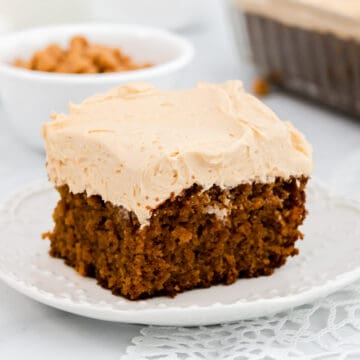
Butterscotch Cake with Butterscotch Frosting
Ingredients
For the cake:
- 2 ⅔ cups all-purpose flour (measured correctly: spooned into the measuring cup and leveled off – don't scoop and pack the flour into the cup)
- 1 (3.4 ounce) box butterscotch instant pudding mix, reserve 1 tablespoon for the frosting
- 2 teaspoons baking powder
- ½ teaspoon baking soda
- ½ teaspoon salt
- 1 cup unsalted butter, room temperature (2 sticks)
- 1 ⅔ cup packed dark brown sugar
- 3 large eggs
- 1 ¼ cup milk
- ¼ cup vegetable oil
- 2 teaspoons vanilla extract (or vanilla bean paste)
For the frosting:
- 1 ½ cups unsalted butter, room temperature (3 sticks)
- 1 cup butterscotch chips, melted (measure before melting)
- 1 tablespoon butterscotch instant pudding mix (reserved from the cake batter earlier)
- ¼ teaspoon salt
- 5 cups confectioner’s sugar
- 1 teaspoon vanilla extract (or vanilla bean paste)
- 2-3 tablespoons milk
Instructions
For the cake:
- Preheat the oven to 325 degrees F.
- Grease or spray a 13×9 inch pan and set aside.
- In a medium-sized mixing bowl, add the flour, baking powder, baking soda, salt and package of butterscotch pudding mix (making sure to reserve one tablespoon of the mixture for the frosting). Whisk well and set aside.
- In another bowl, add the eggs, milk, oil and vanilla. Whisk well.
- In a large mixing bowl, cream the room-temperature butter and the brown sugar.on medium-high for about two minutes.
- Alternately add the flour mixture and the milk mixture to the butter and sugar. (Add in ⅓ of the flour mixture and mix on medium just until combined. Add in ½ the milk mixture, mix on medium just until combined. Continue with another ⅓ of the flour mixture, mix, then the last of the milk mixture mix, then the last of the flour mixture and mix.) Mix only until well combined. Mixing for a couple minutes at this point will cause the cake to come out dense.
- Scrape down the sides of the bowl and mix again only for about 10 seconds.
- Bake at 325 degrees F for about 45-50 minutes. A toothpick inserted into the middle will come out with a few moist crumbs on it or clean, but no liquid batter.
- Cool the cake in the pan on a wire rack completely before adding the frosting.
For the frosting:
- Melt the butterscotch chips for about 20 seconds at a time. Mix until smooth and set aside to cool a bit before making the frosting.
- Add the butter, and cooled down, melted butterscotch chips to a mixing bowl and beat until smooth.
- Add three cups of confectioners sugar and beat on medium until smooth.
- Add in 2 tablespoons of milk plus vanilla extract and the last two cups of confectioners sugar plus the salt and beat again until smooth.
- Add in the tablespoon of butterscotch pudding mix and mix well.
- If the buttercream is too thin, mix in another cup of confectioners sugar. If it's too thick, add in another tablepsoon of milk and mix well.
- Spread frosting onto completely cooled cake.
- See the notes section for best way to store this cake, serve it and for more questions.
Notes
Nutrition
How to Share
I’d love for you to share this recipe link or tag it, but please do not share screenshots or copy/paste the recipe to social media as the content and photographs are copyright protected and we (bloggers) work really hard on our content. Sharing the link, tagging us on socials and pinning it is super appreciated though!
Other Posts You Might Like:
Don’t forget to pin it below!

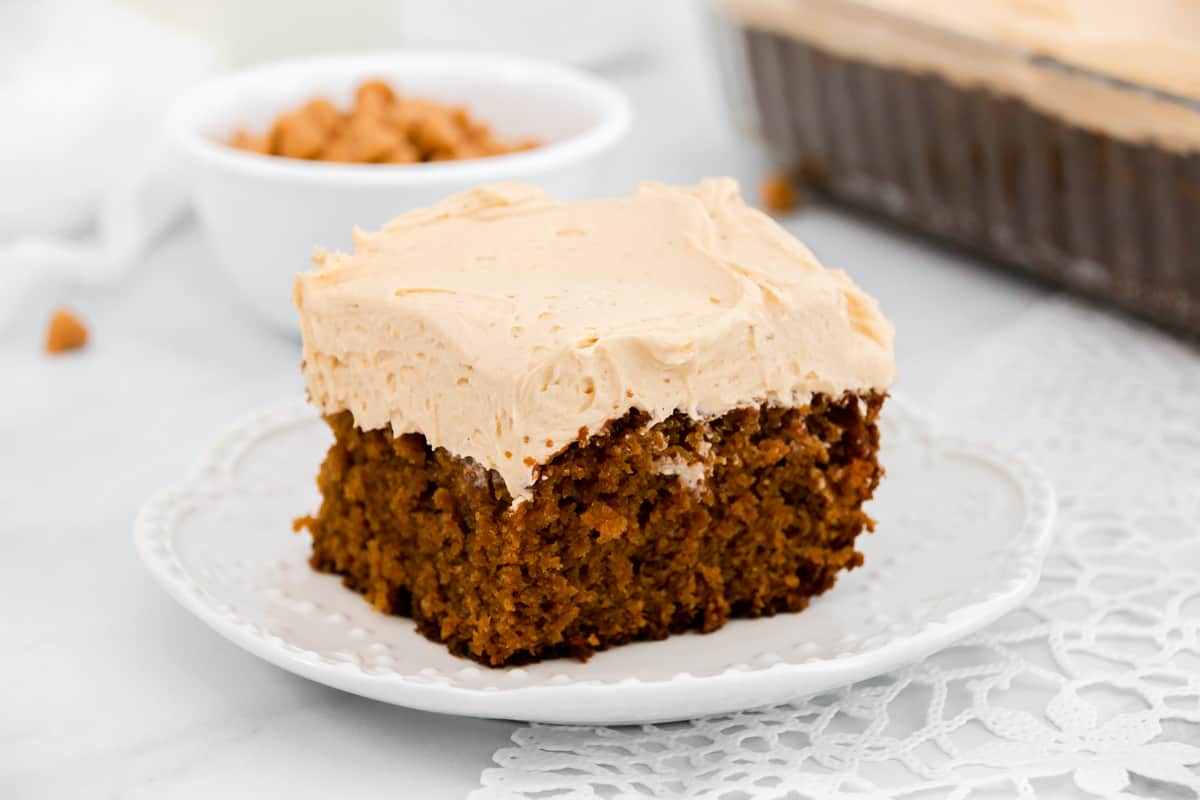
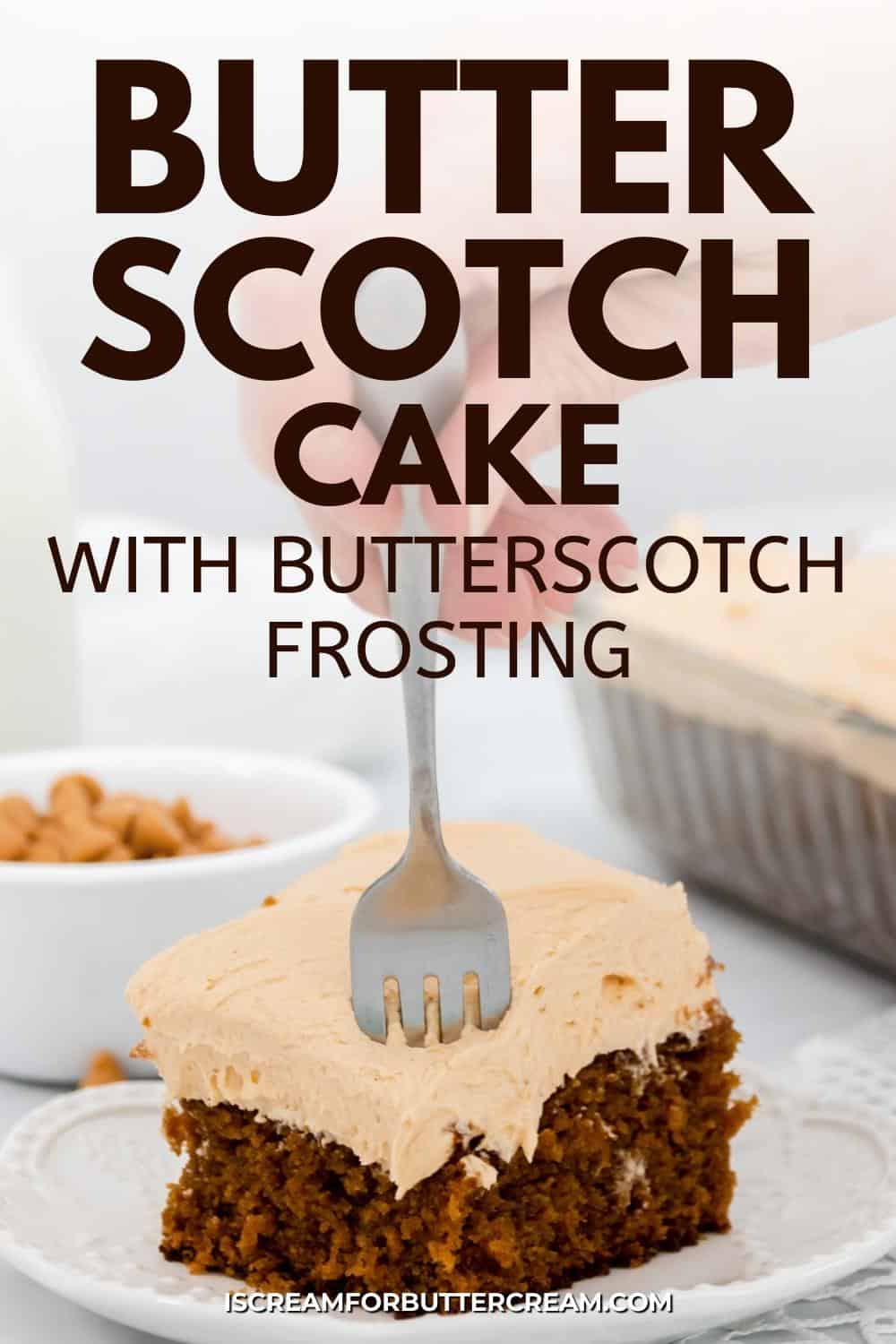
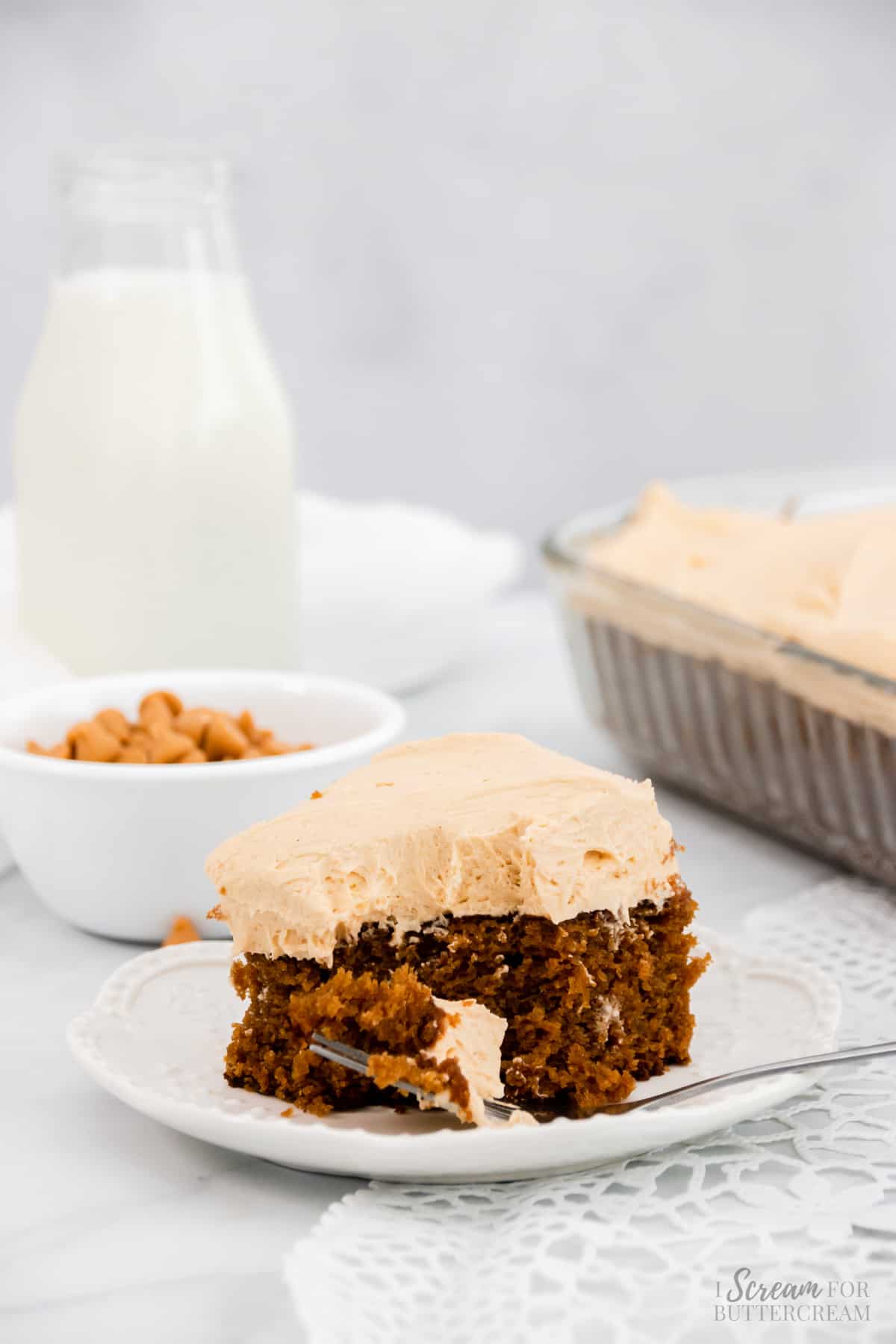

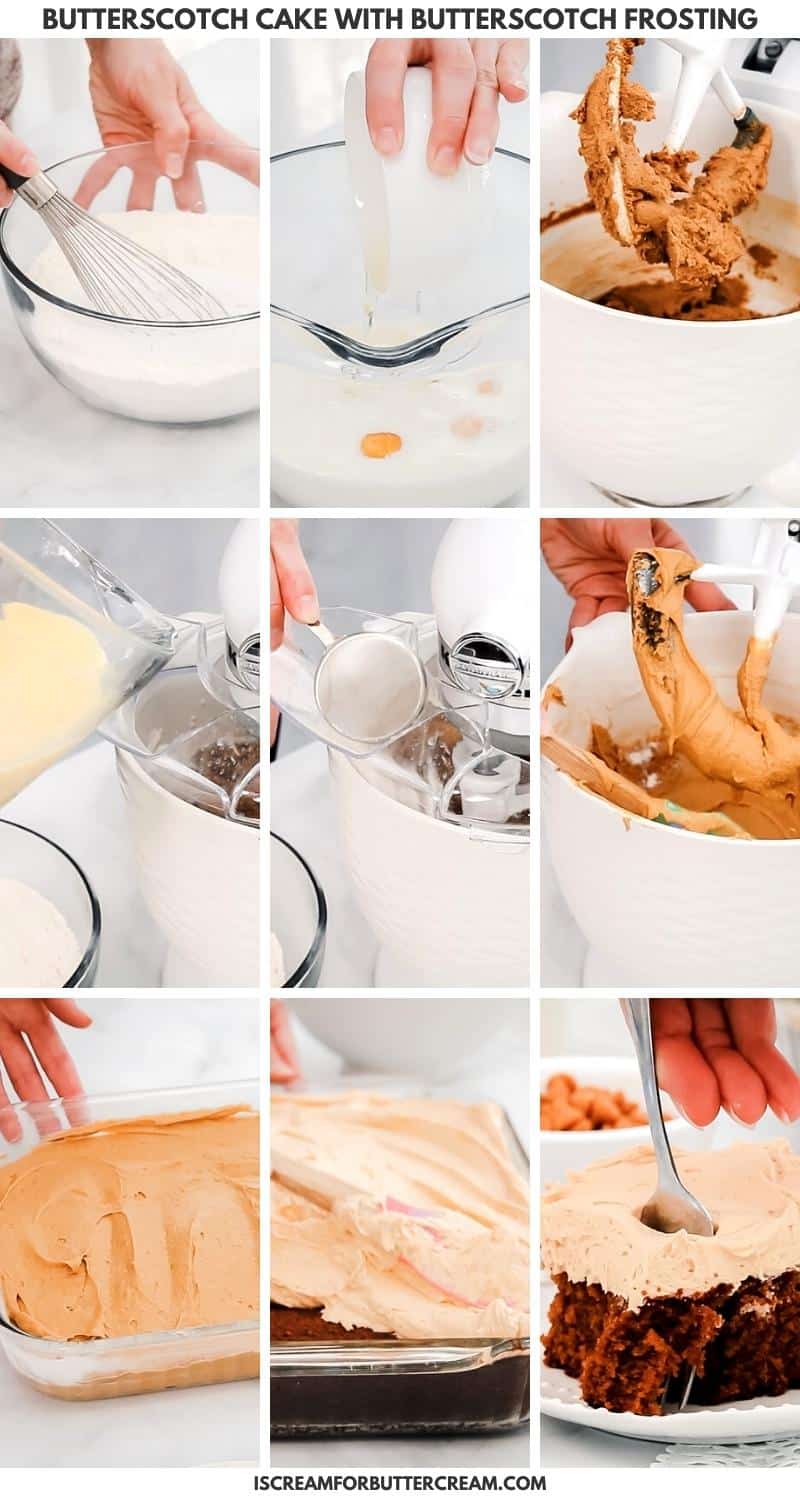
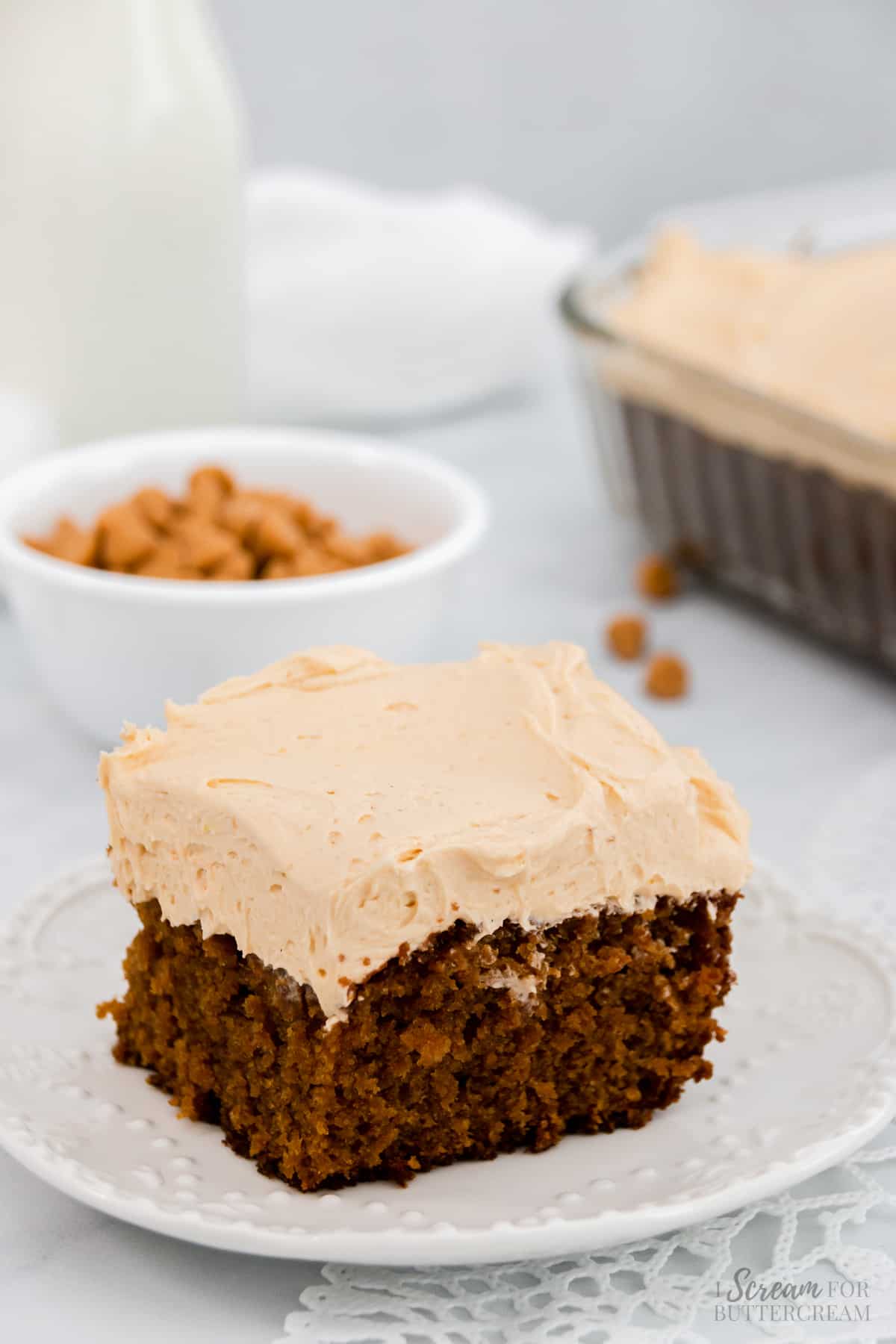
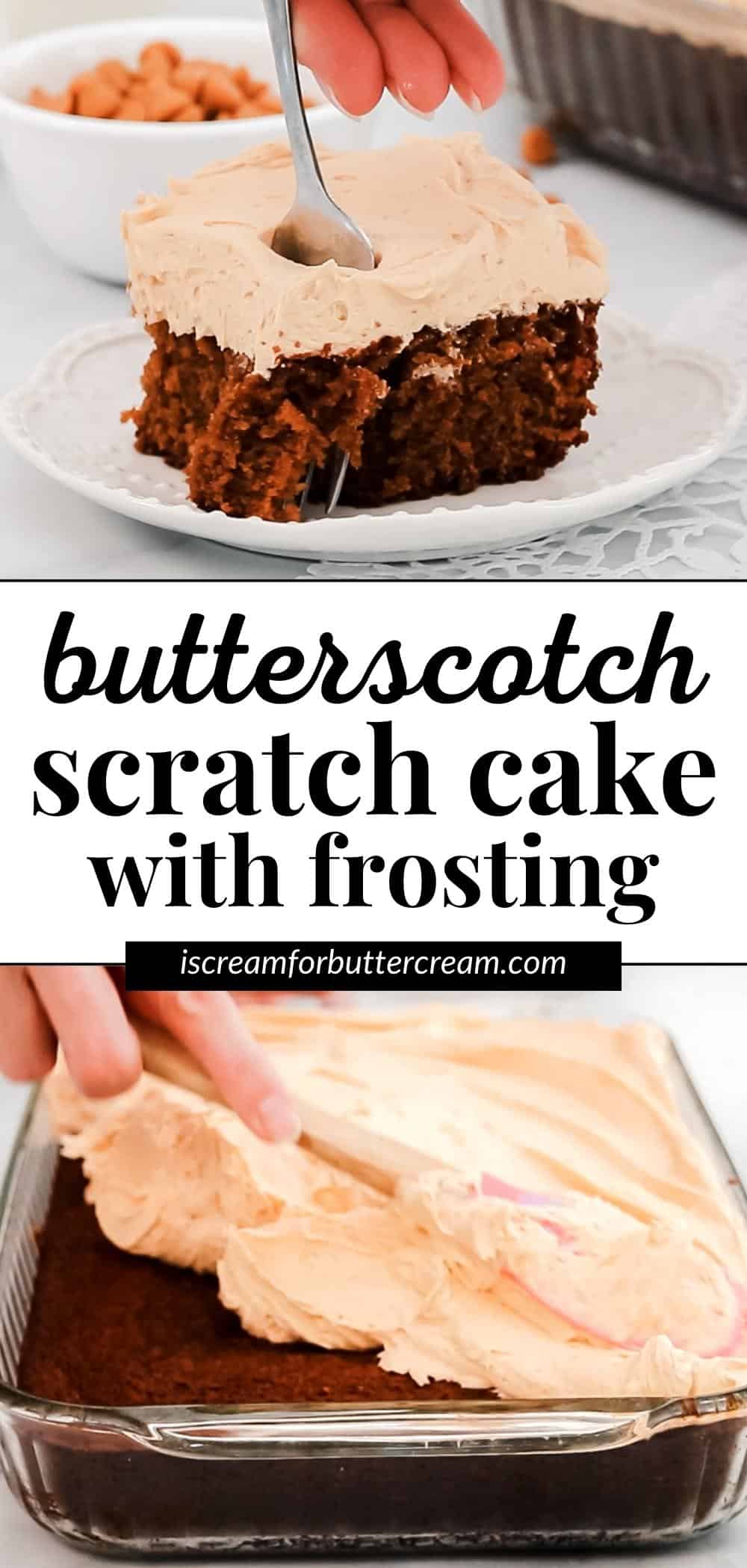
Leave a Reply